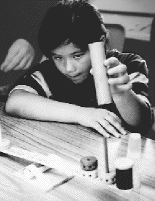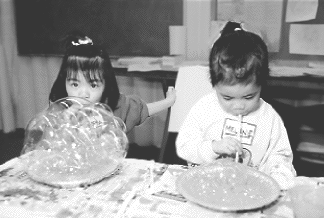Inquiry is central to science learning. When engaging in inquiry, students describe objects and events, ask questions, construct explanations, test those explanations against current scientific knowledge, and communicate their ideas to others. They identify their assumptions, use critical and logical thinking, and consider alternative explanations. In this way, students actively develop their understanding of science by combining scientific knowledge with reasoning and thinking skills.
An Introduction to Inquiry
--National Science Education Standards
As we grow up, we all develop everyday, common-sense views of the world. These ideas may get us through the day and help us make sense of what we see and experience on a practical level, but they aren't necessarily in concert with the current scientific view of the world. The earth, for instance, looks flat from our perspective; the sun appears to move across the sky. There's no real reason to think otherwise--unless we're helped to see and understand it differently. Children need to develop a scientific view of the world, and to really understand the meaning of scientific concepts. One critical aspect of science education is to help children develop the skills they need to think like scientists in their pursuit of understanding.

Children need to be nurtured to fully develop their abilities to become
real thinkers--to puzzle through problems, to see multiple ways of
finding solutions, to gather and weigh evidence, and to apply and
test scientific ideas. They need opportunities to experience the joy
of discovery and develop scientific attitudes such as perseverance,
risk taking, curiosity, and inventiveness. These skills of inquiry
can ultimately equip children with the ability to function effectively
as adults, both at work and in the everyday world.
What is inquiry?
Inquiry is an approach to learning that involves a process of exploring the natural or material world, and that leads to asking questions, making discoveries, and rigorously testing those discoveries in the search for new understanding. Inquiry, as it relates to science education, should mirror as closely as possible the enterprise of doing real science.
The inquiry process is driven by one's own curiosity, wonder, interest, or passion to understand an observation or solve a problem.
The process begins when the learner notices something that intrigues, surprises, or stimulates a question--something that is new, or something that may not make sense in relationship to the learner's previous experience or current understanding.
The
next step is to take action--through continued observing, raising
questions, making predictions, testing hypotheses, and creating theories
and conceptual models.
The
learner must find his or her own pathway through this process. It
is rarely a linear progression, but rather more of a back-and-forth,
or cyclical, series of events.
As
the process unfolds, more observations and questions emerge, giving
occasion for deeper interaction with the phenomena--and greater potential
for further development of understanding.
Along
the way, the inquirer collects and records data, makes representations
of results and explanations, and draws upon other resources such as
books, videos, and the expertise or insights of others.
Making
meaning from the experience requires reflection, conversations, comparisons
of findings with others, interpretation of data and observations,
and the application of new conceptions to other contexts. All of this
serves to help the learner construct a new mental framework of the
world.
Good
science education requires both learning scientific concepts and developing
scientific thinking skills. Effective classrooms rely on many different
ways of teaching science. This book is devoted to one approach, inquiry
learning, which has proven to be a powerful tool in learning science
and in keeping wonder and curiosity alive in the classroom.


